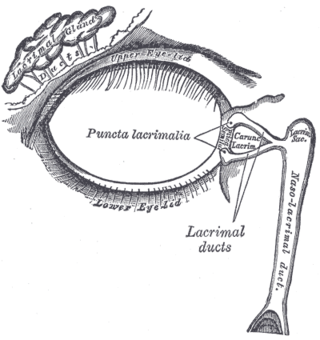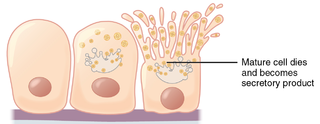Related Research Articles

In animals, a gland is a group of cells in an animal's body that synthesizes substances for release into the bloodstream or into cavities inside the body or its outer surface.

Exocrine glands are glands that secrete substances on to an epithelial surface by way of a duct. Examples of exocrine glands include sweat, salivary, mammary, ceruminous, lacrimal, sebaceous, prostate and mucous. Exocrine glands are one of two types of glands in the human body, the other being endocrine glands, which secrete their products directly into the bloodstream. The liver and pancreas are both exocrine and endocrine glands; they are exocrine glands because they secrete products—bile and pancreatic juice—into the gastrointestinal tract through a series of ducts, and endocrine because they secrete other substances directly into the bloodstream. Exocrine sweat glands are part of the integumentary system; they have eccrine and apocrine types.

A sebaceous gland is a microscopic exocrine gland in the skin that opens into a hair follicle to secrete an oily or waxy matter, called sebum, which lubricates the hair and skin of mammals. In humans, sebaceous glands occur in the greatest number on the face and scalp, but also on all parts of the skin except the palms of the hands and soles of the feet. In the eyelids, meibomian glands, also called tarsal glands, are a type of sebaceous gland that secrete a special type of sebum into tears. Surrounding the female nipple, areolar glands are specialized sebaceous glands for lubricating the nipple. Fordyce spots are benign, visible, sebaceous glands found usually on the lips, gums and inner cheeks, and genitals.

Blepharitis is one of the most common ocular conditions characterized by inflammation, scaling, reddening, and crusting of the eyelid. This condition may also cause swelling, burning, itching, or a grainy sensation when introducing foreign objects or substances to the eye. Although blepharitis by itself is not sight-threatening, it can lead to permanent alterations of the eyelid margin. The primary cause is bacteria and inflammation from congested meibomian oil glands at the base of each eyelash. Other conditions may give rise to blepharitis, whether they be infectious or noninfectious, including, but not limited to, bacterial infections or allergies.

An eyelid is a thin fold of skin that covers and protects an eye. The levator palpebrae superioris muscle retracts the eyelid, exposing the cornea to the outside, giving vision. This can be either voluntarily or involuntarily. The human eyelid features a row of eyelashes along the eyelid margin, which serve to heighten the protection of the eye from dust and foreign debris, as well as from perspiration. "Palpebral" means relating to the eyelids. Its key function is to regularly spread the tears and other secretions on the eye surface to keep it moist, since the cornea must be continuously moist. They keep the eyes from drying out when asleep. Moreover, the blink reflex protects the eye from foreign bodies.

An eyelash is one of the hairs that grows at the edge of the eyelids. It grows in one layer on the edge of the upper and lower eyelids. Eyelashes protect the eye from debris, dust, and small particles and perform some of the same functions as whiskers do on a cat or a mouse in the sense that they are sensitive to being touched, thus providing a warning that an object is near the eye.

A chalazion or meibomian cyst is a cyst in the eyelid usually due to a blocked meibomian gland, typically in the middle of the eyelid, red, and not painful. They tend to come on gradually over a few weeks.

A stye, also known as a hordeolum, is a bacterial infection of an oil gland in the eyelid. This results in a red tender bump at the edge of the eyelid. The outside or the inside of the eyelid can be affected.

The lacrimal glands are paired exocrine glands, one for each eye, found in most terrestrial vertebrates and some marine mammals, that secrete the aqueous layer of the tear film. In humans, they are situated in the upper lateral region of each orbit, in the lacrimal fossa of the orbit formed by the frontal bone. Inflammation of the lacrimal glands is called dacryoadenitis. The lacrimal gland produces tears which are secreted by the lacrimal ducts, and flow over the ocular surface, and then into canals that connect to the lacrimal sac. From that sac, the tears drain through the lacrimal duct into the nose.

Meibomian glands are sebaceous glands along the rims of the eyelid inside the tarsal plate. They produce meibum, an oily substance that prevents evaporation of the eye's tear film. Meibum prevents tears from spilling onto the cheek, traps them between the oiled edge and the eyeball, and makes the closed lids airtight. There are about 25 such glands on the upper eyelid, and 20 on the lower eyelid.

A distichia is an eyelash that arises from an abnormal part of the eyelid. This abnormality, attributed to a genetic mutation, is known to affect dogs and humans. Distichiae usually exit from the duct of the meibomian gland at the eyelid margin. They are usually multiple, and sometimes more than one arises from a duct. They can affect either the upper or lower eyelid and are usually bilateral. The lower eyelids of dogs usually have no eyelashes.

The tarsi are two comparatively thick, elongated plates of dense connective tissue, about 10 mm (0.39 in) in length for the upper eyelid and 5 mm for the lower eyelid; one is found in each eyelid, and contributes to its form and support. They are located directly above the lid margins. The tarsus has a lower and upper part making up the palpebrae.

Holocrine is a term used to classify the mode of secretion in exocrine glands in the study of histology. Holocrine secretions are produced in the cytoplasm of the cell and released by the rupture of the plasma membrane, which destroys the cell and results in the secretion of the product into the lumen.
An apocrine sweat gland is composed of a coiled secretory portion located at the junction of the dermis and subcutaneous fat, from which a straight portion inserts and secretes into the infundibular portion of the hair follicle. In humans, apocrine sweat glands are found only in certain locations of the body: the axillae (armpits), areola and nipples of the breast, ear canal, eyelids, wings of the nostril, perineal region, and some parts of the external genitalia. Modified apocrine glands include the ciliary glands in the eyelids; the ceruminous glands, which produce ear wax; and the mammary glands, which produce milk. The rest of the body is covered by eccrine sweat glands.
Glands of Zeis are unilobar sebaceous glands located on the margin of the eyelid. The glands of Zeis service the eyelash. These glands produce an oily substance that is issued through the excretory ducts of the sebaceous lobule into the middle portion of the hair follicle. In the same area of the eyelid, near the base of the eyelashes are apocrine glands called the "glands of Moll".
Skin appendages are anatomical skin-associated structures that serve a particular function including sensation, contractility, lubrication and heat loss in animals. In humans, some of the more common skin appendages are hairs, arrector pilli, sebaceous glands, sweat glands, and nails (protection).

Hidrocystoma is an adenoma of the sweat glands.

The accessory visual structures are the protecting and supporting structures (adnexa) of the eye, including the eyebrow, eyelids, and lacrimal apparatus. The eyebrows, eyelids, eyelashes, lacrimal gland and drainage apparatus all play a crucial role with regards to globe protection, lubrication, and minimizing the risk of ocular infection. The adnexal structures also help to keep the cornea moist and clean.

Meibomian gland dysfunction is a chronic disease of the meibomian glands, which is commonly characterized by obstruction of the end of the duct that delivers the secretion produced by the glands to the eye surface, which prevents the glandular secretion to reach the ocular surface. The dysfunction could be that the amount of secretion produced may be abnormal. Dysfunction could also be related to the quality of the meibum produced. MGD may result in evaporative dry eye, blepharitis, chalazion, unsealed lid during sleep, and meibomian gland atrophy.